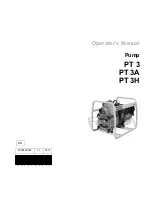
SECTION D: MAINTENANCE INSTRUCTIONS
1. Keep interior of pump and valves clean. When pumping
liquids containing foreign materials, flush out pump with
clear water whenever possible.
2. Keep suction hose air tight and check for leaks and loose
lining, as these are major trouble sources when priming.
3. Valves and valve weights must be straight, seat well and
have no cracks.
4. The capacity of a diaphragm pump will vary greatly
depending on the height of the suction lift and length of
discharge line. A discharge line which is too small, long or
high will cause:
A. Excessive bulging of diaphragm on down stroke.
B. Valves closing with loud snap.
C. Rough operation.
D. Engine overloads and slows down.
E. Reduced capacity.
5. Check all bolts frequently and keep them drawn up tightly.
6.
TO CHANGE DIAPHRAGM:
A. Rotate connecting rod and crank to down position.
B. Remove four bolts at outer edge to take off water box.
C. Remove three bolts at connecting rod and take out
diaphragm.
D. Replace diaphragm with type designed for heavy duty
service as originally supplied with pump. Raised ridges on
diaphragm must fit in grooves in connecting rod and bottom
clamp plate. Insert three bolts and draw up nuts snug.
E. Center diaphragm carefully over water box and clamp
with four bolts to pump frame.
7.
TO CHANGE VALVE RUBBERS:
A. Remove suction and discharge connections and remove
valve rubbers.
B. Place new valve rubber between weight and binder and
insert and tighten 2 screws that hold them together. Tighten
firmly but not so rubber is distorted, causing poor seating.
C. Dowel pin in suction connection and on discharge side of
waterbox must enter hole in valve rubber to locate valve in
correct relation to valve opening.
8. Diaphragm pumps will handle fluids containing
considerable solids, however if mixture is too heavy to
be pumped, liquid must be added until it becomes sufficiently
fluid for pumping.
9. Neoprene and other rubbers can be furnished for the
diaphragm and valve rubbers when pumping fluids
containing considerable oils, greases or chemicals.
10.
ENCLOSED GEAR CASE:
Change the transmission oil after the first 40 hours of
operation. Use an SAE80 -90 wt. EP gear lube. Capacity
is 20 oz. (550ml). Fill to the oil level plug in the transmission
cover. Check oil level periodically and change oil every
400 hours.
11. Change engine oil per manufacturer’s specifications.
Check oil level frequently.
SECTION E: TROUBLE SHOOTING
If your pump does not prime or operate properly, check the
following:
1. Pump may be too high above or far from water.
2. Leaks in suction hose or hose connection to pump.
Check if hose inner lining has loosened. If loose, pump
suction will cause lining to collapse and block hose.
3. Valves may not be seating properly due to accumulation
of residue or wear. They are held between waterbox and
suction and discharge connections and leakage can occur
unless clamped tightly. Pour water in suction chamber to
help seal valves.Valves and valve weights must be
straight, seat well and have no cracks.
4. Check diaphragm for breaks or leaks.
5. Make sure that end of suction line is in position to allow
water to enter; it may be buried in muck or blocked in
other ways.
6. Pump will not operate properly under a positive suction
head condition.
7.
DO NOT
allow any point of the suction hose to be higher
than the suction connection on the pump, trapped air
pocket can form and prevent priming.
SECTION: F REPLACEMENT PARTS
F-1 ORDERING REPLACEMENT PARTS:
When ordering replacement parts,
ALWAYS
furnish the
following information:
1. Pump model number. (F-2)
2. Pump serial number.(F-3)
3. Part description.
4. Item part number.
5. Quantity required.
6. Shipping instructions.
7. Billing Instructions.
F-2 MODEL NUMBER:
This designation consist of numbers and letters which
represents the discharge size, series horsepower, motor phase
and voltage, speed and pump design. This number is used for
ordering and obtaining information.
F-3 SERIAL NUMBER:
The Serial Number block will consist of a six digit number,
which is specific to each pump and may be preceded by a alpha
character, which indicates the plant location. This number will
also be suffixed with a four digit number, which indicates the
date the unit was built (Date Code).
EXAMPLE:
A012345 0490.
Reference the six digit portion
(Serial Number) of this number when referring to the product.
2
1
7
Manual Index
Содержание Barnes 2ADG8
Страница 8: ...Fig 1 8 Manual Index HOME MENU ...
Страница 9: ...Fig 2 9 Manual Index HOME MENU ...
Страница 10: ...Fig 3 10 Manual Index HOME MENU ...






































